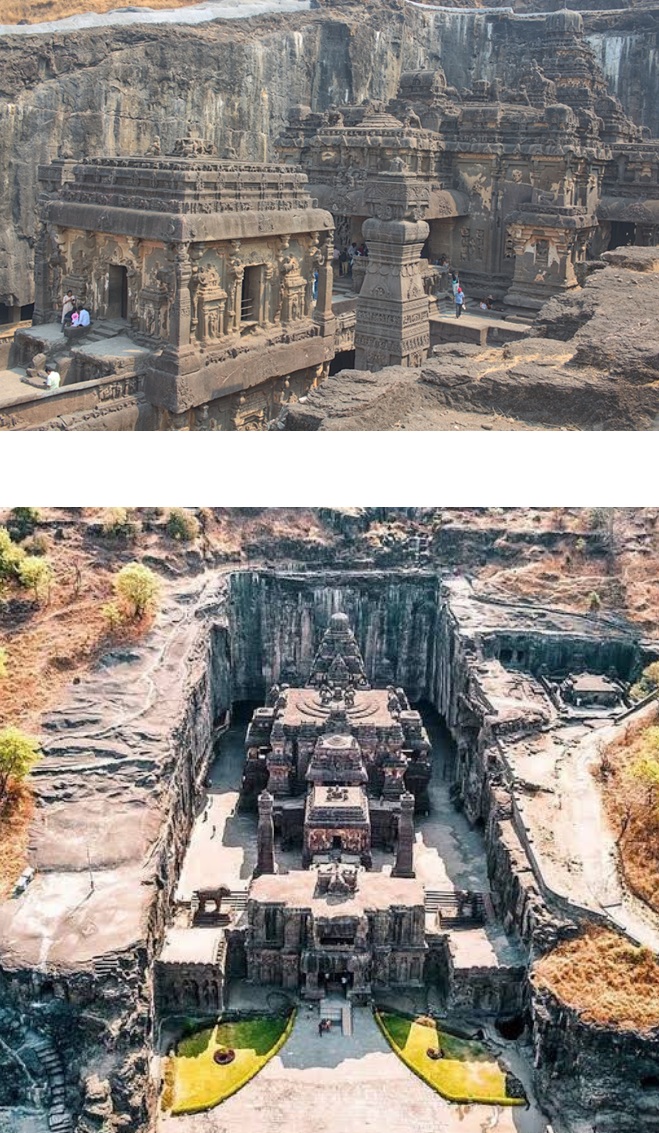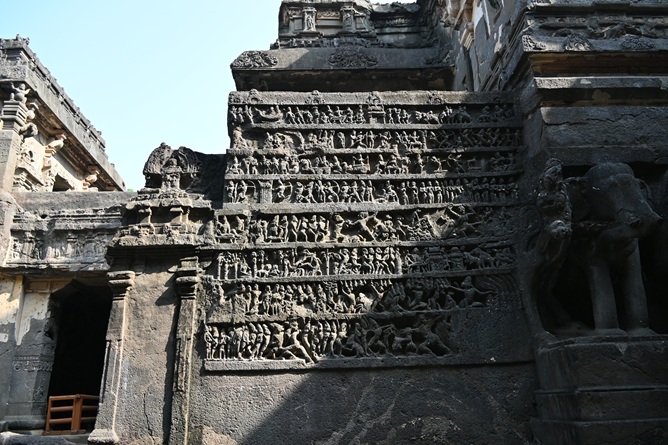| Back to Back Issues Page |
 |
|
Real World Physics Problems Newsletter, Issue #62 November 11, 2025 |
Kailasa Temple and Conflict with ScienceThe Kailasa Temple at Ellora, India is beyond impressive. It is a profound and silent challenge to our understanding of human history. Unlike typical structures built by adding piece after piece, Kailasa Temple was carved out of solid rock in a subtractive process involving the removal of over 400,000 tons of solid basalt rock from the top down in a breathtaking feat of reverse engineering. This monolithic temple complex, with its multi-story towers, intricate pillars, and life-sized elephant sculptures, all carved from a single cliff face, forces onto us a single uncomfortable question: Is the story we tell ourselves about our technological past a complete fiction? The facts of Kailasa are so staggering they border on the mythological. It is the world’s largest monolithic structure, a sculpture on a geological scale where every strike of the tool was irreversible. There was no room for error. This was more than just construction; it was a calculated act of excavation, a testament to a vision so precise that it could see the finished temple hidden within the mountain and had the ability to remove everything that was not part of that image. 
From this undeniable marvel, two irreconcilable narratives have emerged, each reflecting a deeply held worldview about the capabilities of ancient civilizations. The Orthodox Narrative: The Triumph of Will Mainstream archaeology explains Kailasa through a powerful, if almost unimaginable, combination of factors: immense coordinated labor, generational time, and amazing skill using basic hand tools. The prevailing theory describes a meticulous, three-stage process. First, workers isolated a giant block of stone by carving deep, vertical trenches around its perimeter. Then, like master sculptors, they began shaping this monolith from the top down, defining the central tower (shikhara), the inner halls (mandapa), and the surrounding galleries. Finally, artisans moved in to execute the breathtakingly detailed reliefs and statues that adorn every surface. 
This, orthodox scholars argue, was the work of the Rashtrakuta dynasty in the 8th century AD. Over a time span of 150 years, the tools used, they assert, were hammers, chisels, and picks. The methods were ropes, pulleys, levers, and a profound, hard-won understanding of stone. For them, the intricate carvings are the ultimate proof. If artisans could achieve such delicate, lace-like detail with hand tools, then the macro-excavation, however vast, is simply the same skill applied at a larger, more logistically complex scale. The Heretical Challenge: The Whisper of Lost Sciences To the skeptical eye, this orthodox explanation is not just inadequate, but a form of "reality hallucination"—a clinging to a broken model in the face of overwhelming contradictory evidence. The argument from practicality is fierce: it makes zero logical sense to remove a mountain of rock, piece by piece, using primitive tools to form the final structure, rather than just building up the structure piece by piece. The logistics of planning, feeding, and coordinating thousands of workers for generations, all while maintaining a perfect, error-free excavation plan in a subtractive process, seems less like history and more like an implausible fiction. People who insist that only hand-tools were used to build this temple have likely never built anything by hand themselves, maybe not even using Lego as a child. If they had, they would understand the sheer, physical impossibility of the task as described. The reasonable logical conclusion is therefore that advanced technology was used to build the temple rather than primitive hand tools. But this conflicts with the mainstream view, and the cynical accusation often levelled at those that suggest that primitive tools could not have been used is that they are racist and are denying that ancient people had the ability to build great structures using the tools they had at their disposal. So suggesting that they had advanced technology is a way of minimizing their abilities. I personally find this absurd and it is actually a flawed argument. The genius of ancient people to construct such breathtaking monuments came not from an unbelievable skill in working with hand tools but rather in developing and using advanced technology that far exceeds our own. Isn't this where the bigotry lies, in only giving ancient people credit for being brilliant in a lane of our choice, and not allowing for them having their own lane entirely; a lane in which the use of advanced machining and levitation (antigravity) technologies was commonplace. This is ultimately what scholars are uncomfortable with, that this ancient advanced technology dwarfs what we are capable of today, and furthermore contradicts our linear view of technological progress: primitive → ancient → medieval → modern (with technology peaking in our present). We are comfortable with the idea of "genius within constraints," but are profoundly uncomfortable with the idea of "genius that transcends our own paradigm." It would have been much easier to simply build the temple in the normal way by adding piece after piece until it was completed. Even more so if hand tools were used (if that were even possible). But the fact that this temple was instead built in a subtractive manner out of solid rock is a powerful message. The message is that it was EASY to do, and the technology to do so was utilized in such a way that it makes the notion that hand tools were used completely ridiculous, even more so than for other amazing stone structures such as those in Sacsayhuamán, Peru or the Giza pyramids. Other stronger messages that contain real scientific secrets are waiting to be discovered that are currently hidden from view, and are likely located underground beneath some of the enormous and ancient stone structures around the world. For example, remote sensing techniques have recently shown that enormous structures are located underneath the Great Pyramid which are much larger than the pyramids themselves, and extend up to 2 km deep. The Coming Rude Awakening The debate over Kailasa and other similar ancient structures is a proxy for a much larger conflict about the nature of reality and knowledge. It is a battle between a methodologically conservative, evidence-based system and a paradigm-challenging, intuition-based skepticism that sees conservatism as dogma. There is a palpable conviction among skeptics that we are on the brink of a "rude awakening." That one day, incontrovertible proof will emerge—be it a functioning artifact, an unambiguous text, or something more direct—that reveals the existence of an advanced, perhaps non-human civilization that has visited Earth for millennia, sharing their technology with ancient peoples and then taking their technology with them when they left. We are in for a very unpleasant awakening when one day we come face to face with smoking gun direct proof of an advanced, possibly extraterrestrial, presence that has been here for a very long time. I would argue that strong evidence is already here but there are too many convenient places to hide from that reality, especially if you have an internet connection. So the evidence can be ignored, for now, up to the point when it's right at our doorstep, like rising flood waters. When that day comes, the deniers will be exposed as reality hallucinators, and the strongest deniers will mostly be from among the leading figures that have shaped our views; the politicians, academics, historians, religious leaders, scientists, and other so-called "experts" who have based their entire livelihood and careers on certain "truths" being maintained. They will resist this paradigm shift by fighting against it the hardest, gaslighting the hardest, shaming the hardest, and distracting the hardest. But for those who think for themselves and welcome the truth, the newly discovered reality will be beautiful, and they will be ready to embrace it fully. If you would like to comment on this post you can do so on my Patreon page after becoming a member, which is free: https://www.patreon.com/posts/kailasa-temple-143372048 Sources for images First image (top): https://commons.wikimedia.org/wiki/File:Kailasa_Ellora.jpg First image (bottom): https://en.wikipedia.org/wiki/File:Kailash_temple_(Ellora_cave_no_15)_at_Verul.png Second image: https://commons.wikimedia.org/wiki/File:Ellora_caves_-_Kailasa_Temple_(cave_16)_vrvbajel0924_(727).jpg |
| Back to Back Issues Page |